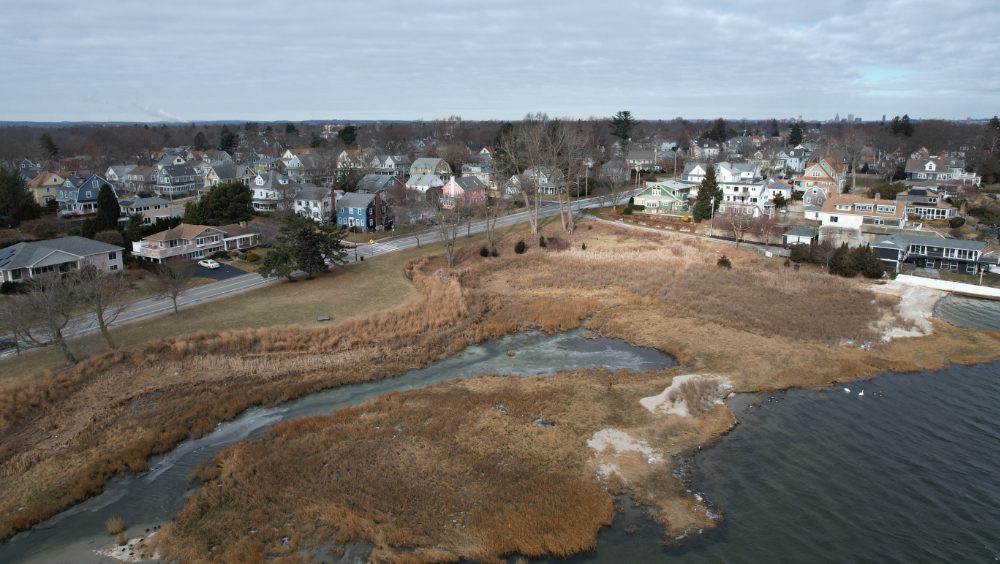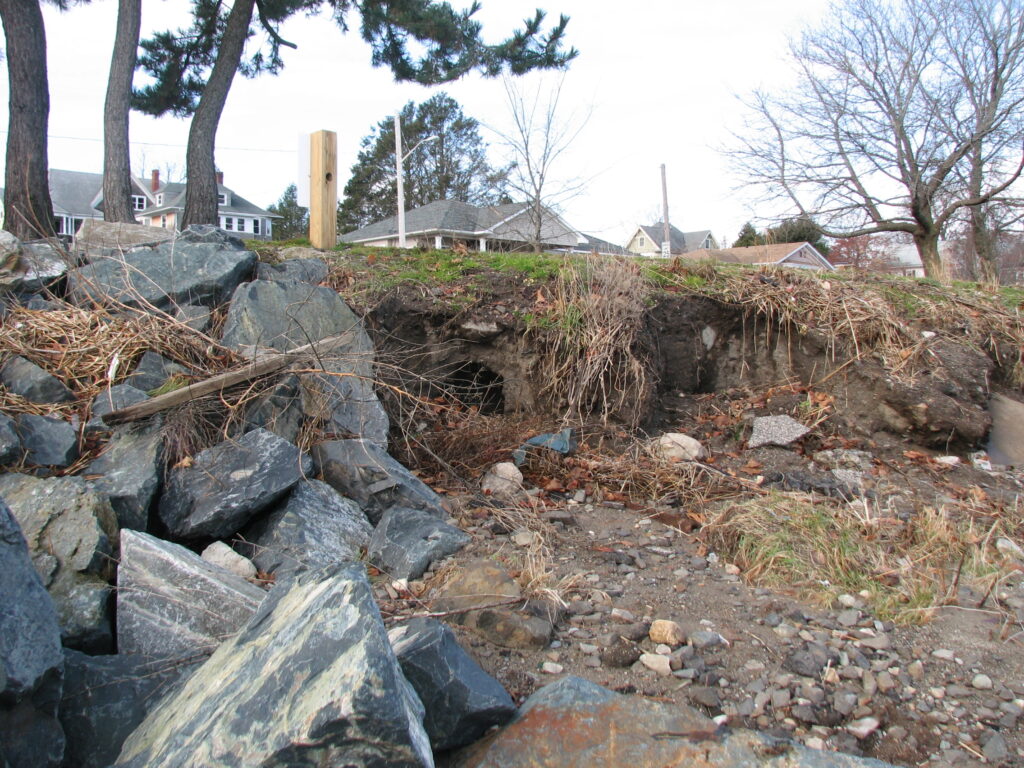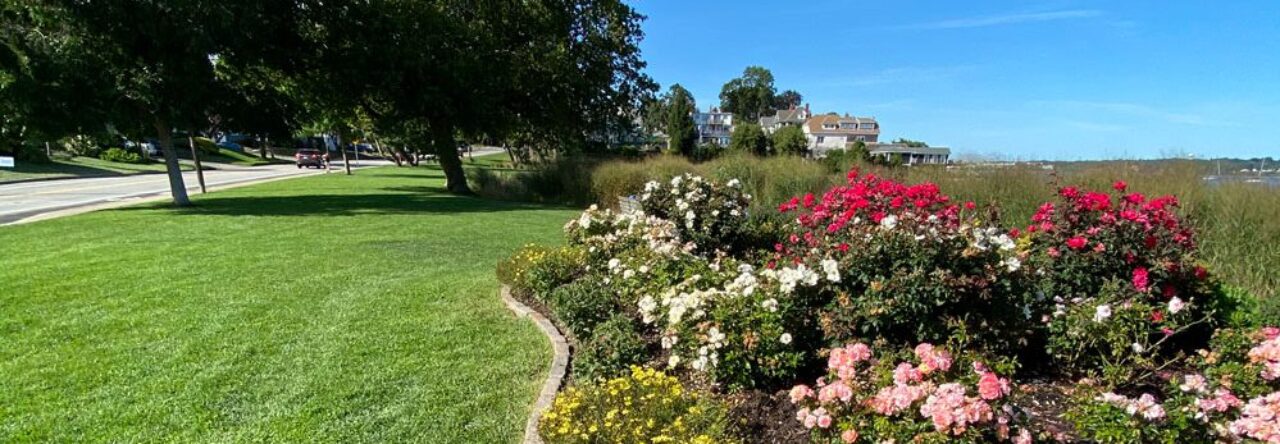We need your help to reinforce the embankment of the Park that has been eroded due to recent flooding. This will be EWPA’s major focus during 2024.
On any given day, our neighbors and friends from Cranston and the surrounding communities enjoy Stillhouse Cove in many ways. They participate in yoga classes, walk dogs, take prom pictures, and access the shoreline or Narragansett Bay via the boat ramp. The Park and Salt Marsh are the focal point of the neighborhood and its popularity grows each year due to environmental restorations and landscape improvements made to this property over the years.

While we all enjoy the beautiful views this site provides, what most visitors don’t see is the hidden damage to the shoreline and marsh from increasingly common extreme weather. The daily news of the consequences and dangers of climate change seem to happen elsewhere, not here. But that is not the case. Coastal erosion is putting our own salt marsh and cove at risk in places not visible to local residents and daily visitors. As stewards of Stillhouse Cove for almost three decades, the Edgewood Waterfront Preservation Association (EWPA) wants you to know about it and to ask for your help.
In December of 2022, the extreme storm that flooded the RI Yacht Club and lower Ocean Avenue pounded the salt marsh. Waves crashed against the banks of the Park, topped the seawall recently installed by the Yacht Club, and flooded the eastern end of the Park at Ocean Avenue. The high tide and crashing waves caused extensive hidden damage to the embankment and the underlying infrastructure that preserves it. In 2013 the EWPA obtained Federal funding to repair damage from Superstorm Sandy that had washed away ten feet of the Park shoreline. With technical input from the Coastal Resources Management Council and Save the Bay, funds were used as part of a “pilot” project to change the slope of the embankments and stabilize the area with custom designed “coir envelopes” that project partners hoped would protect the area from worsening erosion. And it worked for ten years, until it didn’t.

Coir is a natural material made from coconut fibers that is biodegradable. The fibers are woven together to form rolls of fabric that are then turned into custom designed sand filled envelopes that are strategically contoured along the shoreline. Starting at the level of the marsh, each of these envelopes, or “burritos” (as we called them back then) are stacked one upon another with a setback of a few feet. It is the setback that creates a “staircase” like structure that ultimately creates a slope that is more dissipated and a stronger defense against wind-driven waves and rising tides. The bottom coir envelope forms the foundation for the subsequent steps that reconstruct the walls of the Park. The storm that occurred on December 23, 2022 washed away the bottom step of our hidden staircase and this extensive hidden damage now puts the embankment holding up the Park at risk.

The embankment and damaged coir envelopes need important repairs to avoid significant damage to the Park. We need to create a new “bottom step” that is secure enough not to wash away. Two years ago, when a northeast storm was predicted, the EWPA tried to shore up the bottom of the embankment with another product made from coir, coir logs. The logs, bought in New Hampshire and transported by Ray Mooney of Pawtuxet Cove Marina, were installed by a contractor hired by EWPA. Dislodged during a severe storm, they were reinstalled by EWPA volunteers and neighbors during one of our shoreline cleanups. Given all the maintenance performed on the embankments over the past ten years by EWPA, the coir envelopes worked longer than anticipated but were no match for the storm on December 23, 2022.
This past spring EWPA reached out to some of our previous partners from 2013 and sought opinions on the damage we observed. The contractor who installed the coir envelopes in 2013 came to the site to meet with us and Save the Bay to assess the impacted areas. A plan to repair the embankment with an estimate to do the work was generated that day and the costs are significant and need to be done as soon as possible. The work to protect the banks again will be more challenging this time because the slopes are already vegetated and no machinery is allowed in the tidal zone of the marsh. New material will need to be installed in front of what remains of the coir envelopes. The materials will be either new coir envelopes or larger, more substantial coir logs that are secured with stronger supports to keep everything in place.

Plants will need to be installed into the new structures and in front of them to add more protection from strong waves and higher tides. Since coir is biodegradable and sunlight hastens its deterioration, covering the structures with soil and planting into them again will help prolong their effective life. All of this work must be done by hand or done with machinery positioned at the top of the bank.. We will not know until construction begins how much of the Park will be impacted from this repair. It is safe to assume from our previous experience that there will be damage to the lawn and that some portion of the Park will be off limits for a while.
Although we don’t know when the next severe storm is coming, we know it is inevitable and we have an obligation to do all we can to save this beautiful spot which is enjoyed by so many in our community. Please visit www.stillhousecove.org to follow the work being done by your neighbors and friends who donate their time and resources to protect this historic property that is so environmentally fragile. Stillhouse Cove Reservation was created in 1915 by the Metropolitan Park Commission. It has been owned by the City of Cranston since 1984 and officially adopted by the Edgewood Waterfront Preservation Association since 1996.


